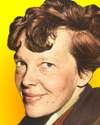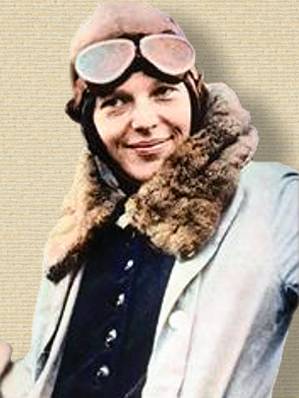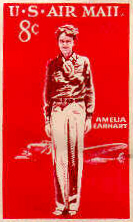 (source)
(source)
|
Amelia Earhart
(24 Jul 1897 - 2 Jul 1937)
American aviator , one of the world's most celebrated aviators, who was the first woman to fly alone across the Atlantic Ocean.
|
Amelia Earhart

Amelia Earhart, born in Atchison, Kansas, was educated at Columbia University and Harvard Summer School. Soon after graduating, she garnered a national reputation as a talented role model. She tirelessly demonstrated to young women that they could succeed in their vocations just as men did. She proved this point time and time again in her own career as an aviator. A kind, soft-spoken, inquisitive and quietly courageous woman, Amelia Earhart was destined to become one of the most familiar and celebrated names of the 20th century.
She received her first flying lesson in 1921, and bought her first plane on her birthday of that year.
In 1928, she became the first woman to fly across the Atlantic, joining American pilots Wilmer Stultz and Louis Gordon on their transatlantic flight. She published the book 20 Hrs., 40 Min. (1928) describing her experience as the first woman to make the crossing by air, followed by The Fun of It (1932).
In 1935, Earhart made a solo flight across the Atlantic, setting a new record time of 13 hours and 30 minutes. Both the American and French governments awarded honors to her for the accomplishment.
On 8 May 1935, with an official invitation from the Mexican government, Earhart became the first person to fly solo between Mexico City and New York City. Her non-stop flight lasted 14 hours and 19 minutes, which set another speed record.
In 1937, she attempted to fly around the world, beginning from Miami, Florida on an eastward flight. Frederick J. Noonan, acted as the navigator. But after flying over 22,000 miles, contact was lost with their plane on a leg from Lae, New Guinea, intending to refuel at Howland Island. She disappeared on 3 July 1937.

Despite the U.S. Navy’s extensive search using ships and airplanes, Earhart and Noonan vanished without a trace. How and why the plane carrying Earhart and Noonan went down remains an enigma.
Her diary and transmissions from her 22,000-mile journey were posthumously published, offering insights into her final travels. Her husband, George Palmer Putnam (1887-1950), a book publisher, edited the book titled Last Flight (1937).
- Science Quotes by Amelia Earhart.
- 24 Jul - short biography, births, deaths and events on date of Earhart's birth.
- Amelia Earhart: The Truth at Last, by Mike Campbell. - book suggestion.
- Booklist for Amelia Earhart.




